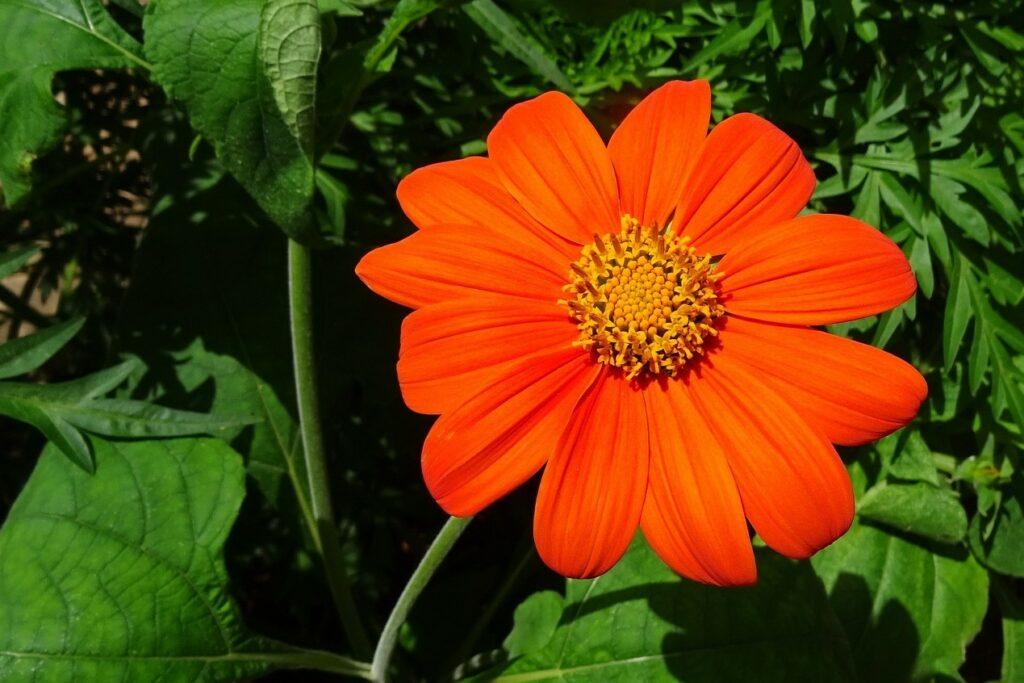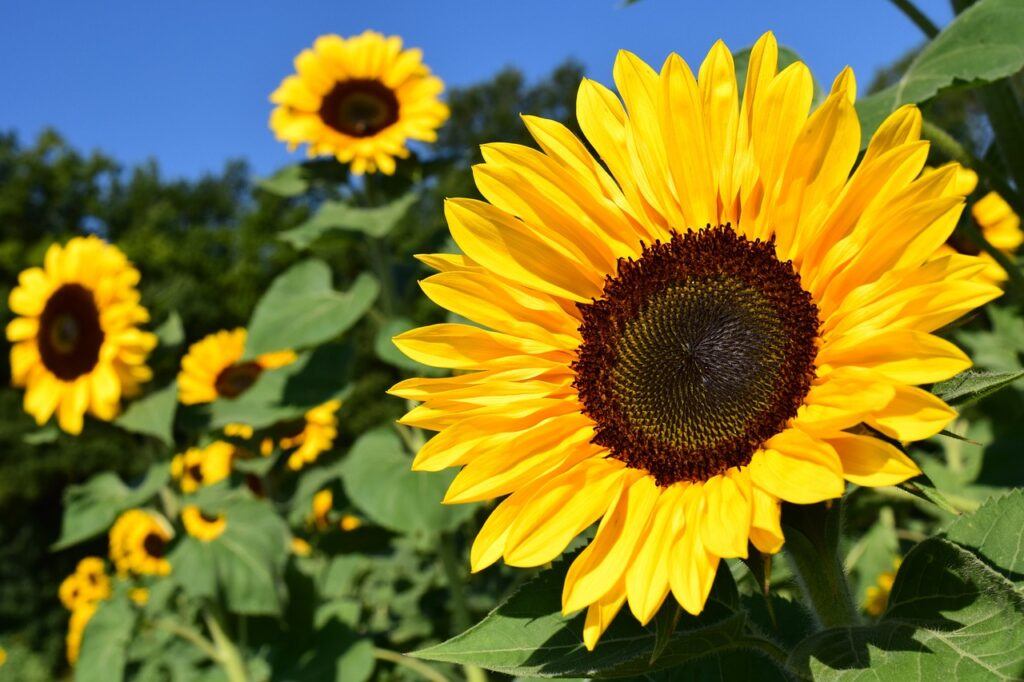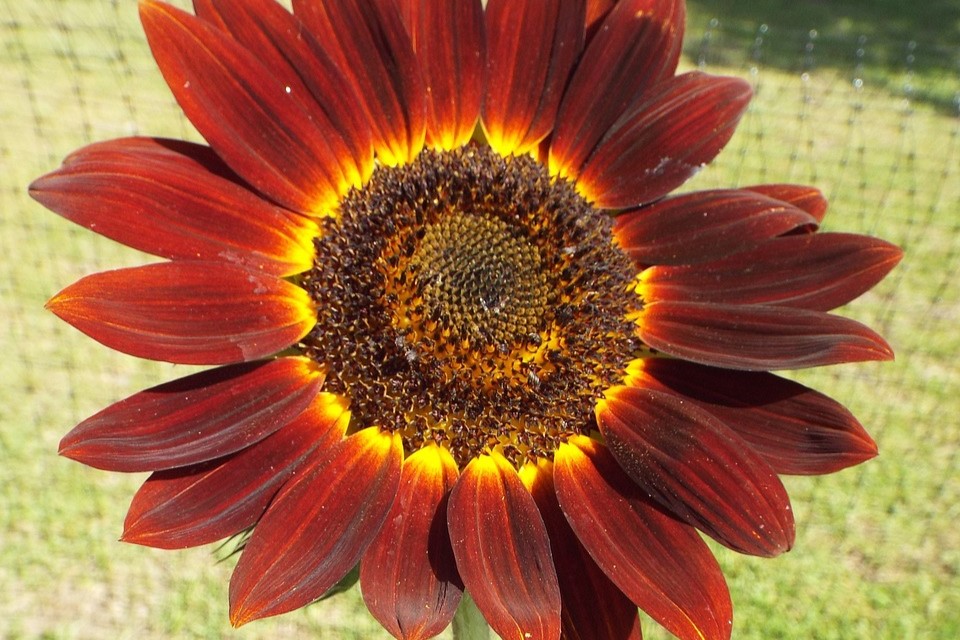Grow Sunflowers
Plant, grow and care for sunflowers easily. With lots of varieties to choose from from short to tall, anyone can enjoy sunflowers all summer long.
Grow sunflowers and you will find they are more than just stunning large flowers. Sunflowers bring wildlife into your yard such as chipmunks, birds and honeybees. The plants become abuzz with activity as yellow finches feed on the ripe seeds, chirping their songs of satisfaction.
Sunflowers are commonly used as temporary privacy screens because of their ability to provide height and side branching that fill space quickly. Those that re-seed each year will provide care-free returns year after year.
Topics in this article:
Basic Needs Of Sunflowers
Thinning Sunflower Plants
Transplanting Sunflower Plants
Maintaining Sunflower Plants
Deadheading
Pruning
Supporting
Sunflowers For Privacy In Small Areas
Do Sunflowers Grow Well In Pots?
Fall Cleanup
Sunflower Varieties
Basic Needs Of Sunflowers
Sunflowers are easy to grow and have minimal environmental needs to survive.
Water
- Generally drought and heat tolerant. If excessively dry for too long sunflower plants show signs of stress by dropping leaves. Avoid stressing the plant by providing ½” to 1” of water per week.
Light
- Full sun is needed for best growth and flower production. Without sufficient light sunflower plants will grow spindly and flowers will be less robust.
Soil
- Tolerate a wide range of soil types, but best in light well drained and somewhat dry soil.
Thinning Sunflower Plants
Choose the most robust plants to keep, and maintain spacing as directed by the planting instructions for your variety.
If plants are crowded, those that get blocked from sufficient sunlight will be spindly. These will rob moisture and nutrients from the others, and not provide much in the way of blooms. You get better yield by maintaining quality plants over quantity when it comes to sunflowers.
Transplanting Sunflower Plants
Sunflower plants have a long taproot which develops quickly as the plant grows. They tend to be set back somewhat by transplanting, so I recommend direct sowing where you want them to grow.
If you decide to transplant, do it when the plants are young (4”-6”) and soak the ground with water a few hours before digging. Dig deep and wide enough so you don’t disturb the tap root, and give plenty of water until established.
Shade the plant from direct sun exposure the first day. The leaves may droop initially, but they should return by next day.
Maintaining Sunflower Plants
Deadheading
Remove spent flowers from multi-branching plants to keep blooms coming all the way up to frost.
Birds will find flower heads that have seeds ripe for their liking. If you want to encourage birds to visit, leave some heads on the plant so they can ripen. Remove the oldest or those that have been partially eaten.
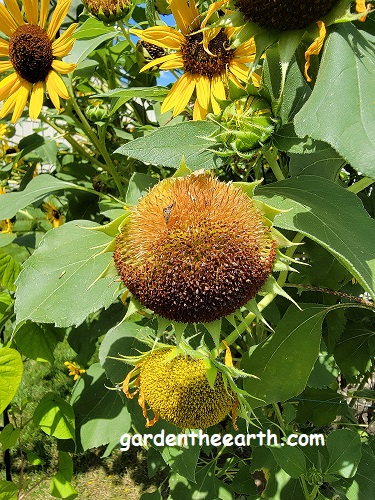
Here is an example of a flower head that has been partially eaten by birds. The top is empty of seeds and the bottom still has seeds in it.
With all the surrounding flowers on the plant, I would cut this one off because there are plenty more to keep the birds coming.
Removing ripening seeds will help promote more blooms.
Pruning
Sometimes side branches of multi-branching sunflower plants will extend into undesirable areas, or add too much weight to one side of the plant.
Long side branches can be trimmed to keep the plant uniform and encourage growth closer to the center stem. Prune branches back to newly forming buds or leaves (see pic).
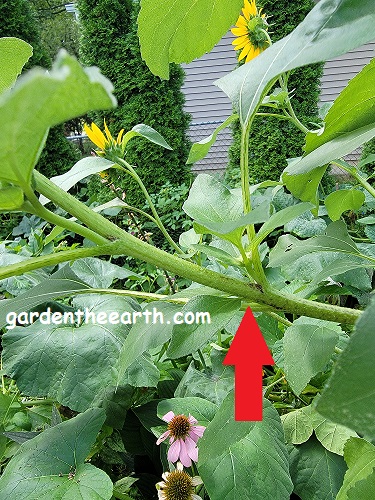
Cut branches back to newly forming buds or leaves.
New branches will grow with new leaves and flowers.
Use this method selectively to avoid stressing plant, especially during hot dry periods.
Supporting
Single head varieties of sunflowers get especially top heavy. Stake individual plants by driving stakes into the ground near the base of the plant and use twine or ties to secure to the stake.
Rows of tall sunflowers may need to be supported with stakes, twine, wire or other means. Exposure to strong winds or thunderstorms could send them toppling if not supported. Put supporting structures such as wire fence in place before the plants start to grow. Train the plants to grow so they use the structure to grow around, or use ties to hold the plants to the structure.
Use ties to support sunflowers around the main center branch as much as possible. Sunflowers have brittle branches that will crack if forced against the direction of growth. If you are trying to keep the plant compact or from “flopping”, tie loosely on side branches or use the trimming method above.
Sunflowers For Privacy In Small Areas
You don’t need to have a large area to take advantage of the privacy a few tall sunflower can provide. Small areas can use sunflowers for privacy too.
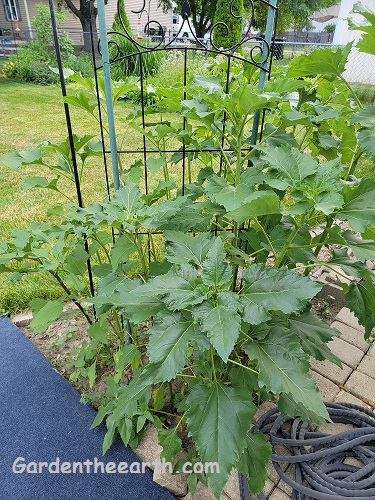
Outside my back door I use a grouping of native sunflowers to create privacy by blocking view from the side and behind.
This triangular area is 4′ x 5′ x 5′. Sunflowers have been re-seeding here for many years on their own.
The trellis and green supporting stakes on either side are placed when the plants are about 6″ – 8″ high. Tall sunflowers are strong plants so I add the stakes to enhance the strength of the support.
Plants are thinned to those that are strongest and will grow where desired. Birds will drop seeds and shells, so plants are thinned so they grow away from the carpeted patio area and air conditioner.
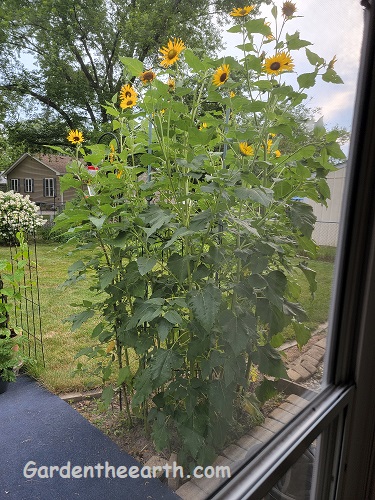
As the plants grow use twine to train them to stay where you want them to grow.
Trim side-branches as needed to maintain compact upward growth.
These sunflowers provide privacy from the back door view, and also for seating on the deck area which is to the left.
Do Sunflowers Grow Well In Pots?
Sunflowers will grow in containers, if soils is kept moist and drains well, and the sunflower gets full sunlight.
Compact shorter varieties up to 4 feet in height are suitable for containers minimum size 5 gallon.
Taller varieties can be grown in containers too, but should have container size minimum 10 gallon. Container should be deep for root growth and stability. Lemon Queen Sunflower is a good choice for a mid to tall sunflower that grows well in a large container.
Fall Cleanup
Tall sunflowers are large plants which means more to dispose of at the end of the season.
A sunflower plant can develop a large woody stem in one season. You may need the large loppers to cut the stems at the base if they don’t pull out. There is typically a “stump” left behind that can be dug up in fall or spring.
The woody stems of tall sunflowers take time to break down in the compost pile. To expedite the process, cut the stems into small sections and turn often. If burning the plants, they will burn quickly once left to dry out and turn brown.
Sunflower Varieties
Choose sunflower varieties by multiple heights, colors and types of flowers.
There are single head and multi-branching sunflower plants to chose from.
- Single head sunflower varieties have one large flower head per plant.
- Multi-branching sunflower varieties branch out and produce many smaller blooms over longer period.
Below find an assortment of sunflowers listed from short to tall.
Elves Blend Dwarf Sunflower
Height: 16″–24″ tall
4″–6″ wide bright yellow and golden, single and double flowers, some with dark centers.
Teddy Bear Dwarf Sunflower
Height: 24–36″ tall, 12″–24″ wide
3″–5″ double, golden-yellow flowers resemble huge chrysanthemums.
Zohar Sunflower
Height: 4’–5′ tall
4″–6″ flower has a classic brown center and golden-yellow petals that are more deeply colored around the center.
Florist’s Sunny Bouquet Sunflower
Height: 4’–6′ tall
Various sizes of different flower types that delight!
Torch Mexican Sunflower
Height: 4’–6′ tall
3″ wide, fiery orange, daisy-like flowers with golden centers.
Rouge Royale Sunflower
Height: 4’–6′ tall
3″–6″ deep red flowers
Vanilla Ice Sunflower
Height: 5′ tall
3″–5″ wide, creamy, light yellow flowers
Goldy Honey Bear Sunflower
Height: 5’–6′ tall, 24″ wide, multi–branching
5″–7″ fully double, golden-yellow blooms. Centers are green until maturity when they turn brown.
Shock-O-Lat Sunflower
Height: 6′ tall
6″ flowers are bronze-red with yellow tips and a dark brown center. Flowers will be smaller if plants are close together.
Drop Dead Red Sunflower
Height: 6′ tall on average
4″–5″ deep red, pollenless flowers in various shades of red.
Heirloom Beauties Sunflower
Height: 5’–8′ tall, 2′ wide, multi-branched
LEMON QUEEN: 5″–7″ wide, lemon yellow. AUTUMN BEAUTY: 5″–8″ wide in autumnal shades of orange, yellow, gold, and maroon bi-colors. VELVET QUEEN: 4″–6″ wide crimson/rust red.
Evening Sun Sunflower
Height: 6’–8′ tall
4″–6″ wide flowers in red, orange, and burgundy with dark centers
Mongolian Giant (single head)
Height: 12′ – 14′ tall
14″-18″ flower heads with yellow petals and a green center







